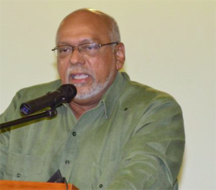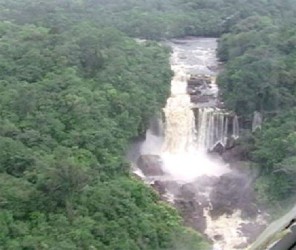Sithe Global yesterday made good on its threat to exit the Amaila Falls Hydro project over the lack of political consensus on the venture but President Donald Ramotar last night vowed to continue working to make the nearly US$900 million project a reality.
Head of NICIL Winston Brassington confirmed Sithe’s exit to Stabroek News but the prospective developer will make an announcement in tomorrow’s Sunday Stabroek on the withdrawal, which is seen as rattling a government that has invested years of effort and money into the controversy-wracked, green energy project in the mineral rich Cuyuni/Mazaruni.
Sithe’s President Brian Kubeck told this newspaper yesterday that the company’s position on political consensus has not changed. Only the PPP/C and the AFC voted in favour of two Amaila matters on Wednesday. The main opposition voted solidly against in a legislature, where the opposition has a one-seat majority.

Kubeck had issued explicit statements that unless all three parties in Parliament backed two Amaila measures for the controversial US$858M project, his company would pull out. At Wednesday’s crucial session of Parliament, the AFC changed its position and voted with the PPP/C while the main opposition APNU voted solidly against. This would have tipped Sithe in the direction of quitting a project that has carved deep divisions in the body politic over its financial architecture and tariffs to consumers.
The Jagdeo administration and the current government have pressed hard for the project but it was eventually compromised by unrelenting questions and analyses from commentators like Christopher Ram, Dr Clive Thomas, Ramon Gaskin and Anand Goolsarran, who argued that the planned 165 MW of hydropower could be obtained at a cheaper cost if unnecessary rates of return and interest charges were stripped away. They had also argued that there was no guarantee that tariffs to consumers would be reduced as had been asserted by the proponents of the project – including all of the leading private sector bodies. They further contended that the Guyana Power and Light remained incapable of functioning as the node for the receipt of power from Amaila and there would be many attendant risks.
In a press release last night from GINA after it became clear that Sithe had exited, President Ramotar said, “I will exert, together with all my ministers and the Cabinet as a whole, we will work hard to try to do what we can to save this project and also try to expand it, try to get this project on stream because it of importance to the development of the country.”
He said that despite efforts to keep the opposition informed about the 165 megawatt project, it has been jeopardised.
The President said that the project is in limbo because Guyana did not meet Sithe’s requirements. “One of the opposition parties voted against it and the other one very belatedly came out in support of it. They did not come up to the level of the debt ceiling that was required for the project itself so that is where the project is, in a lot of uncertainty at this time,” GINA quoted the President as saying.
The release noted that while the AFC supported the government in order that the Hydro-Electric Power (Amendment) Bill was given passage, the government’s motion to increase the debt ceiling on external loans to $150B was amended by the same party to $50B. “The proposed sum was to ensure the Guyana Power and Light (GPL) meets its financial obligations with the Amaila Falls Hydro Incorporated, under the Power Purchase Agreement,” said GINA.
According to the President, the government was warning about this all along and presented all the information requested to the parliamentary parties, the AFC and APNU. He said too that the private sector was engaged on the issue.

“We pointed out to everyone that as soon as this project is built, the charges to the public and commercial sector will be cut by 40%. Ten years after, it will be cut by 70% of what they’re paying today and 20 years from now when this project will be handed over it will be cut by 91%. This of course will have huge possibilities for the development of our country, for the attraction of the manufacturing sector, for the creation of jobs for our young people and for the rapid expansion of our economy to give us the bridges and roads that we need to develop our society at a great rate,” said the President.
Sithe Global’s equity contribution into the project was US$157.5 million. Govern-ment of Guyana equity was to have been US$100 million. China Development Bank’s (CDB) loan was to have been US$500.8 million and the Inter-American Development Bank’s (IDB) loan was to have been US$100 million. In addition to these there were a number of costs associated with insurance, lenders’ fees and advisory costs and interest.
Sithe Global spent the last six years developing the project, following its acquisition of the licence that had been granted to Fip Motilall and Enventure.
In April 1998, government signed an MOU between itself and Synergy Holdings Inc/Harza/MWH. In Decem-ber 2012, Synergy/Harza/ MWH submitted a feasibility report to the Government of Guyana. Between 2003 and 2006 the project was delayed due to the eventually unsuccessful privatisation of GPL and the resumption of control by Government of Guyana in 2005. In April 2007 Synergy identified Sithe Global as a potential investor for the project.
In October 2008, Engineering, Procurement and Construction (EPC) bids came in from five qualified bidders. In December 2008, China Railway was selected as EPC contractor. In December 2009 the EPC price was reduced from the original bid price.
In October 2009, Synergy transferred its interim licence to Sithe Global. In July 2010, a framework agreement was signed with China Development Bank (CDB). The Project Agreement was initialled with Government of Guyana and mandate letter signed with the IDB in September 2012. In January 2013 the IDB and the CDB began due diligence documentation, scheduled for completion by the third quarter of this year.
Critics have slammed the project’s ever-increasing costs and noted that there is no telling what the final price tag of the project will be. Just two weeks ago, the price being touted by the government was US$840 million. However, at a forum last week Wednesday, Sithe Global revealed that the price for the project was a grand US$858.2 million.
In September 2008, the project was pegged at between US$400 million and US$500 million. Further, at that time, the project was being described as one that would be done in phases, stepping up to 410 megawatts and eventually 1 gigawatt, some of which would be exported to Brazil.
However, in 2009 the project was pegged at between US$500 million and US$600 million. By early 2011, it was priced at between US$650 and US$700 million. It shot up to US$835 million by September 2011.





